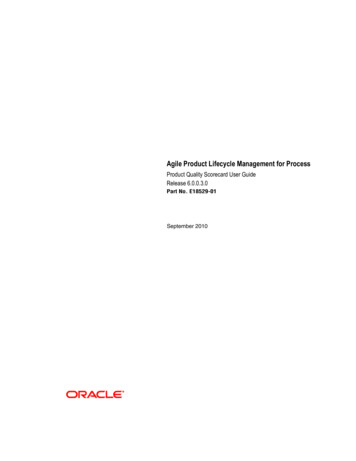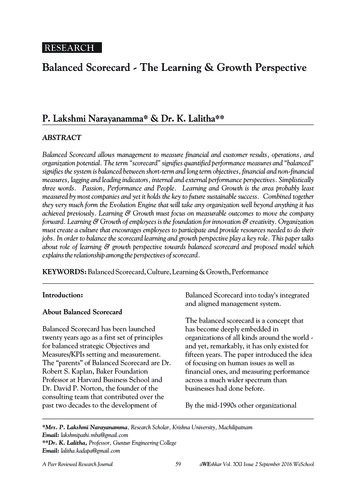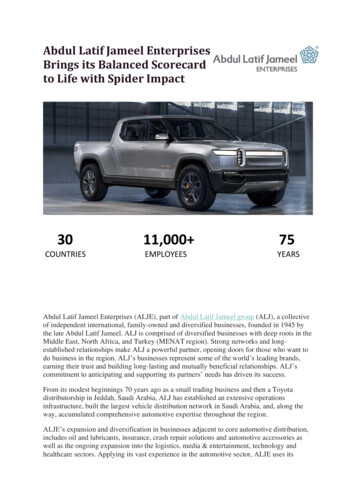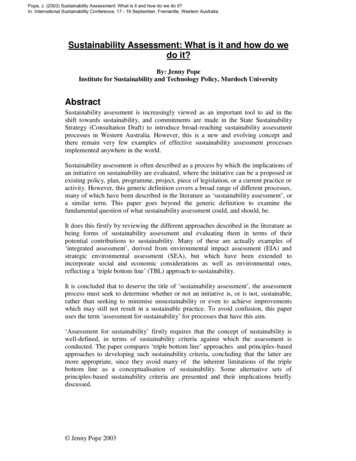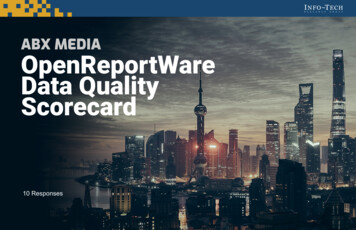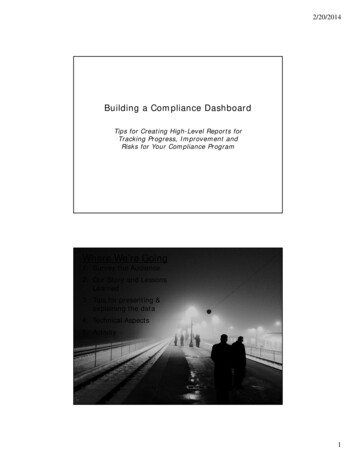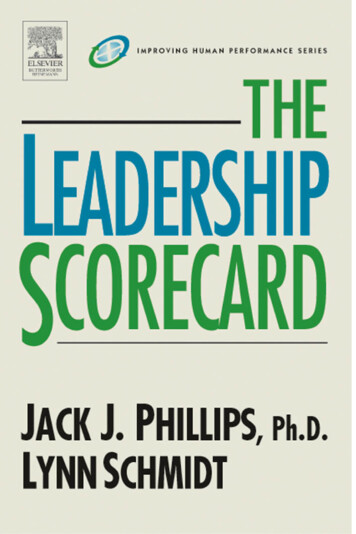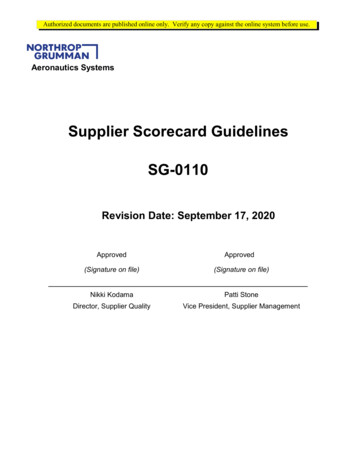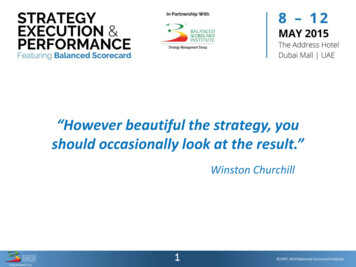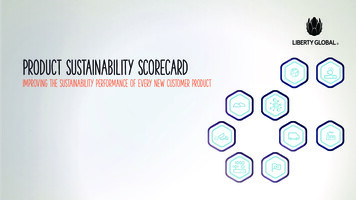
Transcription
front coverProduct Sustainability ScorecardImproving the sustainability performance of every new customer product
EXECUTIVE SUMMARY1PRODUCT SUSTAINABILITY HTING8CASE STUDY9WHAT’S NEXT?6-7102
executive summaryWhat is the Product SustainabilityScorecard?A tool to measure and improve thesustainability performance of Liberty Global’scustomer products.Why is the scorecard important?Embedding sustainability into our productdevelopment process will allow Liberty Globalto deliver more sustainable products, mitigaterisk, improve operational excellence andinnovation, and maintain brand value.How does the scorecard work?What are the results of the first product?What next?The Product Sustainability Scorecard worksby identifying our products’ most importantenvironmental and social impacts.Liberty Global’s first global connectivityproduct, now distributed in 21 countryoperations, was used to test the ProductSustainability Scorecard.The Hub 3.0 results form a baseline tomeasure future broadband products against.Our aim is to improve the sustainabilityperformance of our products relative to thisbaseline.Each impact area (e.g. resource consumption)contains questions about the characteristicsof the product across the lifecycle stagesThe answers to the questions provide twotypes of results:How was the scorecard developed? A score out of 10 for each impact area– this is used internally to tell us if we’reontrack and where we need to focus ourefforts to improve the overall sustainabilityperformance of the productLiberty Global and sustainability consultancyThinkstep have collaborated to create theProduct Sustainability Scorecard. Comparable measures of impact thatdemonstrate if the product is moresustainable than the lastWhen compared to the previous wifi hubdistributed in the UK, for example, theConnect Box / Hub 3.0 delivers increasedwifi capabilities, and new features such asInternet of Things and telephony, yet it ismore energy and resource efficient: 15% more energy efficient1 during use avoiding enough electricity to power over7,000 UK homes each year2 Avoiding1 173 metric tons of plastics, metalsand electronics and saving 40 metric tonsof paper from documentation and 311metric tons of cardboard from packaging1 Energy and resource efficiency is calculated based on relative performance of the products that takes into account increases in functionality.2 Based on average UK household energy consumption (Source: DECC, 2015).Liberty Global Product Sustainability Scorecard 1
Product Sustainability ScorecardAn introductionOur Environmental Statementaddresses the environmentalimpacts generated throughour business. Now we havelaunched “sustainability bydesign” into our productdevelopment process. Thisprogram is underpinned bythe Product SustainabilityScorecard; a uniquetool to measure productenvironmental and socialsustainability.Our environmental statement can be viewed on the Liberty Global website.Our goal is to ensure that as we developproducts, we integrate sustainability intothe development process, right from thebeginning. This means creating productsthat millions of customers across the worldwill love and that have an environmental andsocial story we can all be proud of.This tool enables us to measure the impactsof our products so that we can improve theirsustainability performance with each productiteration.With the Product Sustainability Scorecard,we are now able to compare products ina like-for-like manner and demonstrateimprovements made throughout the productdevelopment cycle – considering everythingfrom packaging design to the accessibility ofthe user interface.Three important things to remember about theproduct sustainability scorecard***It reflects both environmental and social impactsIt underpins the commitment, outlined in our EnvironmentalStatement, to address the environmental impacts generatedthrough our businessIt will influence the design and development of our productsright from the initial conceptLiberty Global Product Sustainability Scorecard 2
Contextwhy it’s important to create the Product Sustainability scorecardOur products serve over 25 million cablecustomers in more than 30 countries and,given the scale of the product manufacturingoperation, improving the sustainabilityperformance of our products is not an easychallenge.By creating the Product SustainabilityScorecard, we can ensure that we focus onthe right areas to improve the environmentaland social impacts of future products.Each product has around a thousand componentsThese Components come from around50 different suppliersThese individual components are sourcedfrom several different countries includingchina, japan, usa, germany, thailand andtaiwanLiberty Global Product Sustainability Scorecard 3
processDesigning the Product Sustainability scorecardWhen we set about designingour scorecard we askedthree big questions. Theanswers gave us the basisfor the Product SustainabilityScorecard.1. What environmental and social issues aremost relevant for customer products?This helped us to identify our impact arease.g. climate change.2. What specific activities in the life cycleinfluence these issues?The answers to this gave us the categorieswithin the impact areas to measureagainst. e.g. power consumption.3. How can we measure the performance ofthese categories?This gave us the specific questions toscore the categories against. e.g. powerconsumption in active use.To answer these questions, wecarried out a range of internaland external reviews thatincluded: External benchmarking of impact areasagainst other companies and sectors Life Cycle Assessment on our previousbroadband box, the Super Hub 2“ Review of relevant standards andguidelines, including the EU’s eco-designrequirements Internal and external stakeholderinterviews to identify the most importantimpact areas. For example, we interviewedour own product development and designleads and consulted the advisory panel atThinkstep Technical review conducted by WRAP,the not-for-profit promoting sustainableresource useWRAP’s mission is to accelerate the move to a sustainable, resource-efficient economy andwe’re pleased to see Liberty Global taking such a proactive and methodical approach tosustainability. This gave us the specific questions to score the categories against. e.g. powerconsumption in active use.We reviewed Liberty Global’s Product Sustainability Scorecard in detail and believe it will play akey role in identifying the environmental and social impacts of their customer products, furtherdelivering progress towards their goal of creating more sustainable products.- Norah Lewis, Technical Specialist, WRAPLiberty Global Product Sustainability Scorecard 4
Structurethe impact areas that create the Product Sustainability ScorecardWe identified the mostimportant social andenvironmental impactareas.For each of these impact areas, welooked at how they are relevant to ourcustomer products. These issues formthe basis of the products’ sustainabilityperformance and the structure of theProduct Sustainability Scorecard.Impact on natural environmentSupply chainResource consumptionReviewing where and howour suppliers source thecomponents that make up ourproducts, to avoid harmingbiodiversity and degradingthe robustness and quality ofecosystems.Ensuring the supplierswho make our productshave stringent policies andpractices in place. Coveringconflict minerals, labor andbusiness practices, sustainablesourcing etc.Promoting circular economyprinciples, especially whererare and non-renewableelements are present.Climate changeProduct responsibilitywasteReducing power consumptionof products in use and standbymodes to improve energyefficiency and decreasegreenhouse gas (GHG)emissions.Ensuring products areaccessible for everyone to useand support safe browsing andviewing help to keep youngpeople safe online.Increasing equipmentrefurbishment and recyclingand improving resourceefficiency.Liberty Global Product Sustainability Scorecard 5
MethodologyHow the results are calculatedEach impact area contains aset of questions mapped to aspecific lifecycle stage of theproduct. Question are scoredindividually out of 10.Some questions are based on'absolute performance' of theproduct.Other questions are based on 'relativeperformance' according to thefunctionality compared to the previousversion of the product.What is the % ofproduct that can berecycled at end of life?What is the powerconsumption duringnormal use?Are tools available tosupport safe browsingand restriction ofaccess to adultcontent?What proportion ofthe product (by mass)can be recycled?Are auto sleep andstandby optionsactivated by default?What is the packagingmass?There are over 80 questions in the ProductSustainability Scorecard and they are scoredin different ways.Liberty Global Product Sustainability Scorecard 6
MethodologyHow the results are calculatedThe answers to the questionswithin each impact areaprovide two types of results.ImpactLifecycleStageProduct &ManufacturingPackagingQuestionWhat is themass ofelectroniccomponents &boards in thisproduct?Whatpercentage ofthe productis made ofrecycledcontent?1. An internal measure of progressEach of the questions within each impactarea is scored individually out of 10 andweighted according to its importance (seepage 8 for more information on how wedetermined the weightings).The sum of the weighted scores for allquestions in an impact area give the overallscore for that area, which is also out of 10.When we’re developing a new product, wewill use the impact area scores to identifywhere we’re improving the sustainabilityperformance of the product and where weneed to focus efforts.Resource ConsumptionResponse100g 90%Score 2. Impact reduction measuresBy comparing the characteristics ofthe product against to the previousmodel, using both absolute and relativecomparisons, we can demonstrateimprovement across environmental andsocial impact measures such as powerconsumption, raw material use andaccessibility.Liberty Global Product Sustainability Scorecard 7
WeightingHow we decide which impact areas and questions are most importantThere is no standard protocolto follow when designinga holistic sustainabilityscorecard for customerelectronic products. So inorder to decide the weightingsfor the impact areas and thequestions within those impactareas, we considered a rangeof factors: How other external organisations weightheir issues, such as the EPA ScienceAdvisory Board The global versus the local scale andimpact of the issue Stakeholder expectations about whichissues should be more of a focusImpact Area WeightingQuestion Weightingenergy consumption duringresourceconsumptionimpact on thenatural environmentmaximum use The level of information available on theissuesidle use32%48%Example: The ‘Resource consumption’ impact areahas a higher weighting than ‘Impact on the naturalenvironment’. This is because the former has ahigher impact when looking at lifecycle assessmentresults and is more of a focus of stakeholders, whoare concerned about end of life impacts.The latterincorporates issues like the toxicity of chemicals usedin production processes and emissions to air andwater, but these are typically localized issues.Example: For climate change, the ‘energy consumptionduring maximum use’ question accounts for 48%of the total score for that impact area, whereas ‘idleuse’ accounts for 32% because that reflects theconsumption split in a typical user scenario.Liberty Global Product Sustainability Scorecard 8
Case StudyVirgin media uk - are our products performing more sustainably?We used the ProductSustainability Scorecard toassess the Connect Box,marketed as Hub 3.0 inthe UK. This box deliversincreased wifi capabilities, andnew features such as Internetof Things and telephony. Theassessment found that theConnect Box is more energyand resource efficient thanthe previous connectivity boxin distributed in the market.In fact, it is: 15%1 more energy efficient during use avoiding enough electricity to powerover 7,0002 UK homes each year. Avoids 173 metric tons of plastics, metalsand electronics and saves 40 metric tonsof paper from documentation and 311metric tons of cardboard from packaging.311METRIC TONSCARDBOARD& PACKAGING40 PAPERMETRIC TONSSAVED1 Energy and resource efficiency is calculated based on relativeperformance of the products that takes into account increasesin functionality.2 Based on average UK household energy consumption (Source:DECC, 2015).173METRIC TONSPLASTICS,METALS &ELECTRONICSAVOIDEDLiberty Global Product Sustainability Scorecard 9
What’s next?We’re not done yetOur first ProductSustainability Scorecard formsthe baseline for all futurebroadband products to bemeasured against.1. Impact on the environmentWe continue to work with our suppliersto improve their environmental impactsand utilize their expertise in lifecyclethinking and eco-design.2. Resource consumptionMany teams at Liberty Global will be involvedin ensuring the scorecard is embedded intoour processes to drive an improvement in thesustainability performance of our products.We focus on reducing the weight ofelectronics relative to the functionalityof the product, and introduce recycledcontent into the product casing.3. Climate change40% of the energy our routers use in 24hours is from their idle modes, so we’regoing to focus on making them moreefficient.4. WasteWe further advance our ability torefurbish, reuse and recycle ourproducts by making it even easier todisassemble products into constituentparts.5. Supply chainWe work with our suppliers to securethe highest standards in all areas ofsocial issues such as labor rights andfair business practices.6. Product responsibilityWe maintain our high standard byensuring all our products are accessibleand are used in a responsible way,and look to improve where and whenpossible.Liberty Global Product Sustainability Scorecard 10
Product Sustainability Scorecard. Structure the impact areas that create the Product Sustainability Scorecard Impact on natural environment Reviewing where and how our suppliers source the components that make up our products, to avoid harming biodiversity and degrading the robustness and quality of ecosystems. Climate change Reducing power .
